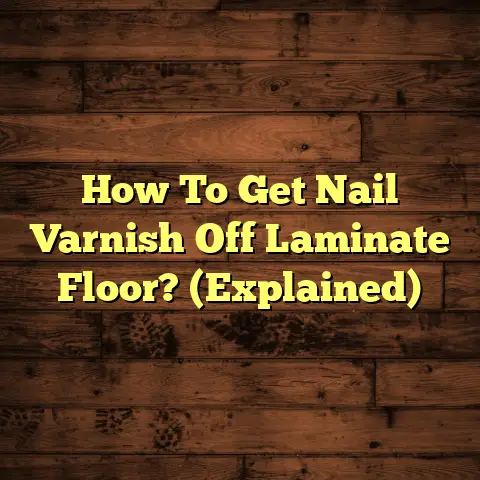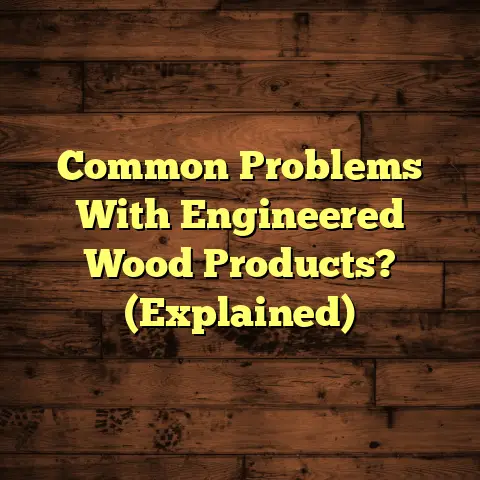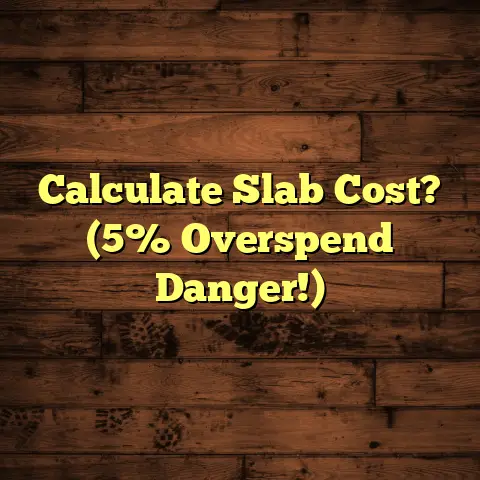What Is The Cheapest Void Fill For Concrete Floors? (Explained)
I remember the first time I faced the challenge of filling voids in a concrete floor. I was working on a residential project, and the client was concerned about some uneven areas that had developed due to settling. The thought of having to deal with those gaps was frustrating, especially knowing how essential it is to have a solid base for any flooring installation. No one wants to deal with creaky floors or uneven tiles after all that hard work, right?
The Importance of Void Fill
When it comes to concrete floors, filling voids is not just about aesthetics; it’s about ensuring structural integrity and preventing future problems. I’ve seen firsthand how voids can lead to bigger issues down the line, like cracking or even sinking floors. So, finding an affordable solution to fill these voids became my mission.
Over the years, I’ve experimented with various materials, and let me tell you, some options are more cost-effective than others. If you’re in the same boat and looking for the cheapest void fill for concrete floors, let’s dive into my experiences and insights!
Exploring My Options
I started my journey with a few common materials used for void filling. Here are some of the most cost-effective solutions I found:
1. Flowable Fill
Flowable fill is a lightweight material that has gained popularity for its ease of use and affordability. It’s a mix of cement, fly ash, water, and sometimes aggregates.
- Cost: Prices typically range from $100 to $150 per cubic yard.
- Application: I found it particularly useful for larger voids and can be poured directly into the space. It flows easily and fills gaps well.
- Pros & Cons: It’s great for quick jobs but can be more expensive than other options if you’re filling small voids.
Personal Experience with Flowable Fill
Let me share a specific project where I used flowable fill. It was a large warehouse that had developed significant voids due to settling over the years. The owners were concerned about safety and potential damage to the flooring above.
I decided to use flowable fill for its quick application and structural benefits. After preparing the site and ensuring that all debris was cleared, we mixed the flowable fill according to the manufacturer’s specifications. Pouring it into the voids was surprisingly straightforward; it settled perfectly into every nook and cranny.
Within a day, we had a solid base ready for further flooring installation. The client was thrilled and relieved that we could solve their problem efficiently. This experience reaffirmed my belief in using flowable fill when dealing with larger voids.
2. Gravel and Sand Fill
Using gravel or sand is one of the oldest tricks in the book. I often use this method when dealing with shallow voids or as a base layer before applying a more permanent solution.
- Cost: Gravel generally costs around $30 to $50 per cubic yard, while sand is slightly cheaper at $25 to $40.
- Application: Simply pour it into the void and compact it down.
- Pros & Cons: This option is very budget-friendly but can settle over time if not compacted properly.
Challenges with Gravel Fill
While gravel is an economical choice, I’ve encountered challenges when using it in certain applications. One notable project involved filling voids beneath a concrete slab in a residential home.
After pouring gravel into the voids, I realized that many areas were not compacted adequately. A few months later, during a routine check, I noticed some settling had occurred, which created new uneven spots on the surface.
To remedy this, I had to return to the site and recompact the gravel while adding more material where needed. This experience taught me that while gravel is cost-effective, it requires meticulous attention during installation to ensure proper compaction.
3. Polyurethane Foam
This is where things get interesting. Polyurethane foam has been a game-changer for me in filling voids.
- Cost: While it’s more expensive at approximately $500 to $1,000 for a full foam injection job, it provides excellent results.
- Application: This foam expands to fill gaps and can be injected directly into voids.
- Pros & Cons: It’s incredibly effective but might not be the best choice for every budget.
Success with Polyurethane Foam
I recall a commercial project where we faced significant settling issues due to poor drainage around the building. The client was looking for a long-term solution. After assessing the situation, I recommended using polyurethane foam.
The injection process was straightforward; we drilled small holes into the concrete slab and injected the foam. Watching it expand and fill every void was fascinating! Within hours, we had solidified the area, and the client was amazed at how quickly we addressed their concerns.
This method proved its worth when we saw no signs of settling even months after completing the job. However, it’s essential to note that while foam provides immediate results, its initial cost can be daunting for smaller budgets.
My Experience with FloorTally
When it comes to estimating costs for different filling materials, I rely heavily on FloorTally. This software has transformed how I approach budgeting and project planning. For instance, when I was working on a commercial space that had several voids needing attention, I input all the necessary details into FloorTally.
It helped me quickly compare costs for flowable fill versus gravel and sand. Not only did it pull local material prices, but it also provided accurate labor estimates based on current rates in my area. This allowed me to present my client with a well-informed budget that included all potential expenses upfront.
Comparing Costs and Benefits
When considering which option is best for your project, weighing costs against benefits is crucial.
- Flowable Fill: While more expensive upfront, it offers durability and ease of application.
- Gravel/Sand Fill: Very cost-effective but requires careful installation and maintenance.
- Polyurethane Foam: Provides excellent results but comes with higher costs; ideal for significant voids or settling issues.
Final Thoughts on Choosing Void Fill
Finding an affordable method to fill voids in concrete floors doesn’t have to be daunting. Through my experiences, I’ve learned that while options like flowable fill and polyurethane foam come with higher costs, they often save money by preventing future repairs.
Remember that each project is unique. Consider your specific needs and budget before making a decision. And if you’re ever uncertain about what to choose, chatting with fellow contractors or tapping into resources like FloorTally can guide you toward making the best choice for your project.
Maintenance Considerations
Once you’ve filled those voids, maintenance is key. Here are some tips:
- Regular Inspections: Keep an eye out for any signs of settling or cracking in your flooring.
- Moisture Control: Make sure there are no moisture issues that could compromise your fill material.
- Professional Help: Don’t hesitate to call in professionals if you notice significant changes in your floors.
Additional Practical Tips
- Document Everything: Keep records of materials used and their costs; this can help you in future projects.
- Use Quality Materials: Sometimes opting for slightly higher-quality materials can save money over time by reducing maintenance needs.
- Communicate with Clients: Always have open discussions about budget constraints and possible compromises on material types based on their requirements.
- Educate Yourself Continuously: Stay updated on new materials and techniques in flooring; this can give you an edge over competitors.
- Network with Other Contractors: Sharing experiences can lead to discovering new methods or materials that work better than what you currently use.
Technical Specifications
When dealing with flowable fill, understanding its properties is crucial:
- Density: Typically ranges from 100 to 125 pounds per cubic foot.
- Compressive Strength: Can reach up to 1,000 psi in just a few days.
- Setting Time: Generally sets within 24 hours but can vary by mix design.
For polyurethane foam:
- Expansion Ratio: Can expand up to 30 times its original volume.
- Compressive Strength: Often exceeds 40 psi.
- Cure Time: Typically cures within 15 minutes.
Conclusion
Finding an economical way to tackle void fills in concrete floors is all about weighing your options carefully. Each material has its pros and cons—what works best varies based on specific project needs.
Through personal experience and insights gathered over years working as a flooring contractor, I can attest that proper planning and budgeting play crucial roles in achieving successful outcomes. So whether you opt for flowable fill’s ease or gravel’s affordability, just remember that meticulous execution is key!
Have you faced similar challenges? What solutions have you found effective? Feel free to share your thoughts!





